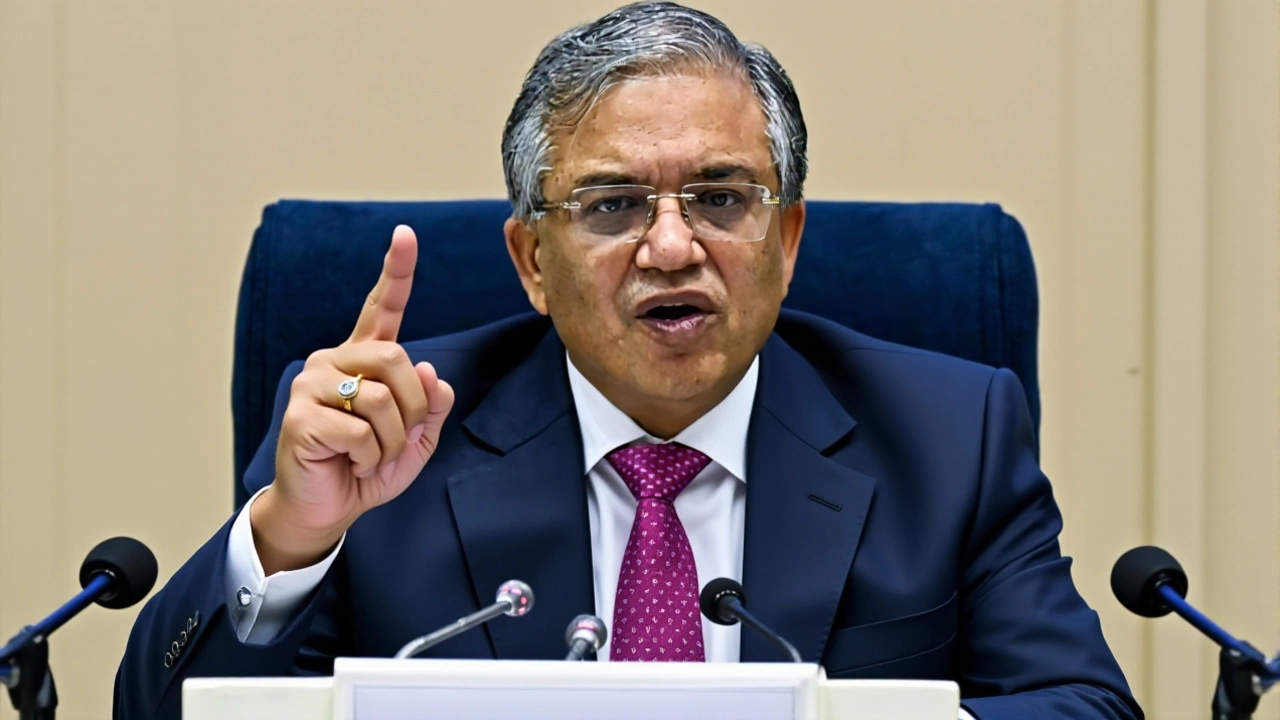JD(U)'s Ram Chandra Sada Wins Alauli (SC) Seat by 35,732 Votes in Bihar Election 2025

On November 14, 2025, at 3:18 p.m. IST, the Bihar Legislative Assembly election results for the Alauli (Scheduled Caste) constituency were officially declared, delivering a decisive victory to Ram Chandra Sada of the Janata Dal (United) (JD(U)). He defeated Rambriksh Sada of the Rashtriya Janata Dal (RJD) by a commanding margin of 35,732 votes, reclaiming the seat he last held over a decade ago. With 93,208 votes — or 53.11% of the total — Ram Chandra Sada not only overturned a narrow 2020 loss but also delivered a brutal blow to RJD’s attempt to hold onto this historically volatile constituency.
A Comeback Decades in the Making
Ram Chandra Sada’s win isn’t just another electoral result — it’s a political resurrection. He first won Alauli in 2010, then lost it in 2015 and again in 2020. In 2020, RJD’s Ramvriksh Sada (no relation) eked out a win by just 2,773 votes — the narrowest margin in Alauli’s modern history. That loss was a shock. Many assumed JD(U) had lost its grip on this Scheduled Caste-reserved seat in the Buxar district of Bihar. But this time, Ram Chandra Sada didn’t just win — he dominated.
The vote count tells a story of consolidation. At 12:15 p.m., he led with 37,521 votes to Rambriksh Sada’s 26,508. By 1:56 p.m., the gap had ballooned to over 26,000. By the final count, the difference was nearly 36,000 — a swing of over 33,000 votes in just four hours. That’s not just momentum. That’s a groundswell.
The Vote Breakdown: A Coalition of Support
JD(U) didn’t win alone. The party’s vote share — 53.11% — was the highest it’s seen in Alauli since 2010. RJD’s 32.75% was its lowest in three elections. But the real story lies in the third-party collapse. In 2020, the Lok Janshakti Party (LJP) held 14% of the vote. In 2025, its splinter faction, RLJP (3 Yash Raj), managed only 8.13% — 14,261 votes. The Jana Sangh Party (JSP) and Bahujan Samaj Party (BSP) combined for under 6%, a fraction of their 2020 influence.
This suggests JD(U) successfully consolidated anti-RJD sentiment — likely drawing in former LJP and even some Congress-leaning voters. The absence of a strong third candidate allowed JD(U) to sweep up the anti-RJD vote. Meanwhile, RJD’s campaign, once dominant in this region, appeared fractured. Local reports say Rambriksh Sada struggled to mobilize youth voters, and his campaign lacked the energy of 2020.

Historical Context: A Seat That Shifts Like Sand
Alauli has always been a political seesaw. In 2015, Chandan Kumar of RJD won with 51.57% — a landslide by Alauli standards. But in 2010, Ram Chandra Sada won with 49.63%, beating LJP’s Pashupati Kumar Paras by 17,523 votes. The seat has changed hands every five years since 2010. What’s different now? JD(U) ran a tighter, more localized campaign. Door-to-door outreach. Community meetings. Emphasis on education and sanitation — issues that mattered to Dalit voters.
Also telling: the counting center was in Begusarai, not Buxar. That’s unusual. It suggests the Election Commission anticipated high turnout and logistical strain. And yet, the results were consistent across India Today, NDTV, The Times of India, and the official Election Commission of India portal — no discrepancies, no disputes. Rare in Bihar’s volatile elections.
What This Means for Bihar’s Political Landscape
JD(U)’s win in Alauli is more than symbolic. It’s a signal to the National Democratic Alliance (NDA) that their strategy in Scheduled Caste constituencies is working. After losing ground to RJD in 2020, JD(U) has reasserted itself as the dominant force among Dalit voters in central Bihar. That’s critical — because if JD(U) can hold Alauli, they can hold other SC seats like Kanti, Buxar, and Barh.
For RJD, this is a warning. Their traditional base isn’t invincible. The party’s reliance on caste identity alone — without delivering on development — is backfiring. Ramvriksh Sada’s loss wasn’t just about personality. It was about perception. Voters saw JD(U) as the party that could deliver infrastructure, schools, and jobs. RJD? Still seen as the party of rallies and resentment.
And for Ram Chandra Sada? He’s now the only MLA in Alauli’s history to win twice — and with a bigger margin the second time around. He’s not just returning. He’s redefining.

What’s Next?
With his term running from 2025 to 2030, Ram Chandra Sada will likely be eyed as a potential ministerial candidate if JD(U) joins the next state government. He’s already being called the “Dalit face” of JD(U)’s revival. Meanwhile, RJD is scrambling to rebuild in Alauli. A by-election isn’t due for five years — but the party’s leadership is already holding internal reviews. One senior RJD strategist told reporters, “We underestimated the ground game. We thought the name would carry us. It didn’t.”
The Election Commission’s final report, due by December 1, will include voter turnout data. Early estimates suggest turnout exceeded 68% — up from 61% in 2020. That’s not just enthusiasm. That’s engagement. And in Bihar, where politics lives and dies by turnout, that’s the real victory.
Frequently Asked Questions
How did Ram Chandra Sada win back Alauli after losing in 2020?
Ram Chandra Sada won by consolidating anti-RJD votes, especially from former LJP supporters, and running a hyper-local campaign focused on education, sanitation, and job access. Unlike in 2020, when RJD’s Ramvriksh Sada won by just 2,773 votes, JD(U)’s 2025 campaign emphasized tangible development, not just caste loyalty. His personal reputation as a former MLA who had delivered on local projects also helped rebuild trust.
Why did RJD’s vote share drop so sharply in 2025?
RJD’s vote share fell from 34.6% in 2020 to 32.75% in 2025, despite a higher overall turnout. Analysts believe this was due to voter fatigue with RJD’s top-down leadership style and lack of visible development in Alauli. The party also failed to counter JD(U)’s ground-level mobilization. Additionally, the split in the LJP vote — which collapsed from 14% to 8% — didn’t benefit RJD, suggesting many former LJP voters shifted directly to JD(U).
Is Alauli a reliable indicator of Bihar’s overall political trends?
Yes. As a Scheduled Caste-reserved seat in central Bihar, Alauli reflects the shifting loyalties of Dalit voters — a crucial bloc in state politics. Its volatility since 2010 mirrors Bihar’s broader trend: voters reward parties that deliver development over those relying solely on caste identity. JD(U)’s 2025 win signals that the NDA’s strategy of combining caste outreach with local governance is gaining traction, even in RJD strongholds.
What role did the Election Commission play in ensuring a fair count?
The Election Commission of India maintained strict transparency, with live updates from the Begusarai counting center and real-time data shared across major media outlets. No discrepancies were reported between India Today, NDTV, TOI, and the official ECI portal — a rarity in Bihar’s often-contested elections. The consistent vote counts across platforms suggest a well-managed, credible process, which helped reduce post-election tensions.
How does this result affect JD(U)’s chances in the next Bihar elections?
This win strengthens JD(U)’s claim as the leading party among Dalit voters in central Bihar. If they replicate this model in other SC constituencies like Kanti and Barh, they could significantly narrow the gap with RJD. For the NDA, it’s proof that local, issue-based campaigning can overcome RJD’s traditional advantages. Ram Chandra Sada’s victory is now being used as a template for future campaigns across the state.
Who is Ram Chandra Sada, and what’s his political background?
Ram Chandra Sada is a veteran Bihar politician who first won the Alauli seat in 2010 as a JD(U) candidate, serving until 2015. He lost in 2015 and 2020, but returned in 2025 with a stronger mandate. Known for his grassroots connections in Buxar district, he has focused on education and rural infrastructure during his previous term. His 2025 victory makes him the only MLA in Alauli’s history to win the seat twice, and with a larger margin the second time.
